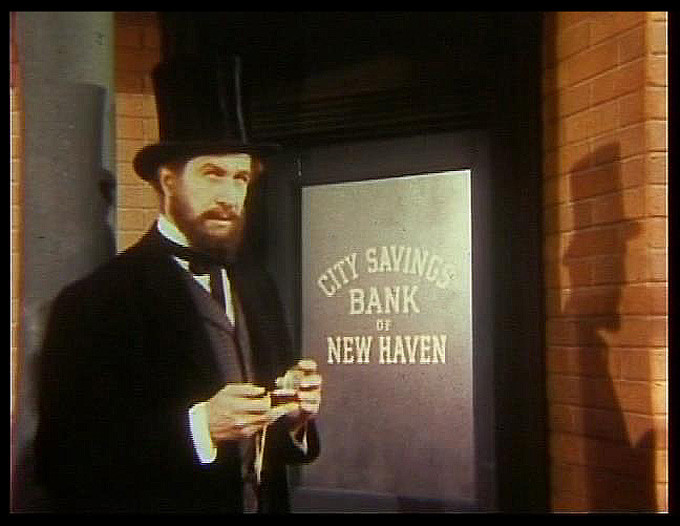Public domain archives offer free access to early documentaries relating to petroleum history.
The history of American radio, TV, and film offers portrayals of the U.S. petroleum exploration, production and transportation industries. Many public domain archives provide free access to early documentaries relating to the history, including oil history videos and the earth sciences, geology, etc.
With its limited resources, the American Oil & Gas Historical Society (AOGHS) can only maintain a limited list of video and research links. Suggestions are welcomed. Often in response to requests for photography resources, AOGHS also has posted some petroleum history video links. Community oil and natural gas museums often preserve local videos, documents, and oral histories.

Clark Gable worked in Oklahoma oilfields as a teenager before moving to Hollywood. This 1940 movie was nominated for two Academy Awards.
The following links are some easily accessible resources. AOGHS encourages follow-up calls and emails that help maintain and expand its links for future mage researchers.
Note that at some sites, downloading materials for personal use with proper attribution of the source is permitted; however, this sometimes does not grant permission to publish. Be sure to examine each site’s copyright requirements. Please support AOGHS.
————————————————————–

The Internet Archive is a nonprofit organization that offers free still and motion media online.
The Internet Archive is building a digital library of Internet sites and other cultural artifacts in digital form. Like a paper library, it provides free access to researchers, historians, scholars, and the general public.
This online archives offers still and motion media, including the Prelinger Archives – which collects, preserves, and facilitates access to films of historic significance. The archives was founded in 1983 by Rick Prelinger in New York City. The collection includes media produced by and for hundreds of corporations, nonprofit organizations, trade associations, community and interest groups, and educational institutions.
The collection includes downloadable files in a variety of formats, for example, the 13-minute “Destination Earth,” (see below) a 1956 cartoon by the American Petroleum Institute. The American Memory project is part of the Motion Picture, Broadcasting and Recorded Sound Division of the Library of Congress in Washington, DC.
America at Work, America at Leisure: Motion Pictures from 1884 to 1915 features job, school, and leisure activities in the United States in 150 motion pictures, 88 of which are digitized for the first time.
More than 60 videos are also available in other American Memory presentations, including the library’s Motion Picture & Television Reading Room.
The films record a wide variety of industrial jobs, and events, including such rarities as the Edison film “Destruction of Standard Oil Company’s plant at Bayonne, N.J., by fire on July 5th, 1900.” The films are keyword searchable, well indexed and can be downloaded.
Academic Film Archive of North America: “The mission of The Academic Film Archive of North America (AFA) is to acquire, preserve, document, and promote academic film by providing an archive, resource, and forum for continuing scholarly advancement and public exhibition. The AFA defines academic film as any film in the broad subject areas of the Humanities and Sciences which were sold.”

This collection includes 150 motion pictures – from which single frames may be captured.
Although offering no online videos, the Smithsonian Institution’s National Museum of American History Archives Center holds Approximately 120 episodes of the “Industry on Parade,” a film collection from 1950 to 1960.
The films are available for research viewing on VHS reference copies. All duplication requests must be reviewed by the center’s audio-visual archivist.
Each “Industry On Parade” episode was 13.5 minutes long and, for most of the series, contained three to four stories examining some aspect of American manufacturing and business. Toward the end of the 1950s, episodes were arranged thematically, featuring a single type of product, industry, or American consumer.
An economic boom that began in western Pennsylvania in 1859 set the stage for an industry that transformed the world,” notes a documentary commemorating the 2009 sesquicentennial of Edwin Drake drilling the first commercial oil well outside Titusville, Pennsylvania.
WQED of Pittsburgh produced the documentary, “The Valley That Changed the World,” in association with the Oil Region Alliance of Business, Industry & Tourism, to educate Americans about the birth of the petroleum industry.
The documentary describes the birth of the petroleum industry and the developments over the ensuing century and a half that affected everyday lives as well as world politics. Using rare photographs, archival materials, interviews with historians and oil families, the evolution of the petroleum industry from an 1859 alternative illuminant to its present day energy dominance is chronicled.
Petroleum Industry Movies
At the top of this informal list of movies with value for energy education (or at least entertainment for those connected to the industry) is “Born in Freedom: The Story of Colonel Drake.” Filmed in 35 mm Technicolor, it was released in early 1954 as the centennial of America’s first oil well approached.

Vincent Price starred as Edwin Drake in the 1954 film sponsored by the American Petroleum Institute. A year earlier he had starred in “House of Wax,” Warner Bros.’ first 3-D movie.
The story begins with Edwin L. Drake sent to investigate an oil seep in a creek near Titusville, Pennsylvania, notes a popular movie database.
Vincent Price stars as the “Colonel” Edwin L. Drake- with a startling resemblance to the historic photos of Drake (the year before Price had starred in “House of Wax,” the first Warner Bros. 3-D movie). Andy Clyde plays “Uncle Billy,” an experienced driller of brine wells. Alan Hale Jr. is tool pusher of the cable-tool drilling rig at Oil Creek.
The 30-minute movie was never released in theaters, but IMDB says it was the first color program showed on the DuMont television network. The plot offers a lesson in early oil exploration, especially technical obstacles encountered and overcome. “Drake’s innovation to shield the well from water entry by using a drive pipe finally allows drilling to proceed until striking oil in August 1859,” IMDB explains.
The movie, produced with funding from major oil companies but never played in theaters, today is regularly shown to visitors at the Drake Well Museum. The corporate film offers lessons in early oil exploration technologies, especially those needed to overcome drilling obstacles.
“Drake’s innovation to shield the well from water entry by using a drive pipe finally allows drilling to proceed until striking oil in August 1859,” explains the IMDB. “It’s a polished production that resembles a B movie of the time; the American Petroleum Institute certainly got its money’s worth,” adds another reviewer.
Beyond “Born in Freedom” (today in need of restoration to its Technicolor original) and the many Hollywood films, including “Deepwater Horizon” of 2016 and 2007’s “There Will Be Blood,” can be found with simple IMDB searches.
Researchers also can be look for an interesting variety of industry sponsored films intended for education but often more interested in public relations. These films can be found on YouTube. Although they have widely varying quality, they still offer insights about the U.S. petroleum industry at the time they were produced.
More modern technical details are in an industry sponsored film for the 1959 oil centennial. “Wildcat” is another 30-minute production from the American Petroleum Institute (API). The film follows two Oklahoma wildcatters preparing to drill an exploratory well with the Big Chief Drilling Company in Garfield County, Oklahoma.
A comment by one viewer notes that the filing location was near Enid, Oklahoma. In the film they drilled to a TD (Total Depth) of 6500 feet, hoping to strike the pay zone known as “The Cherokee Sand.” If they had drilled another 5,000 to 6,000 feet down, they would have hit “The Big Lime.”
“A school teacher/wheat farmer is solicited by several oil companies for the rights to drill on his family’s farm. After accepting an offer he realizes that North Dakota is again a new frontier in America,” says IMDB.
The film “narrates how an oil discovery on a wheat farm in the Williston Basin brings prosperity to the family of a local school teacher. A geologist in the film says that only one out of nine wildcats hits oil, and that a well in that part of America costs half a million dollars,” according to one review.

The American Petroleum Institute produced the 13-minute cartoon Destination Earth in 1956.
“Only one out of nine wells are wet, and it takes them 22 days and 6,750 feet to figure it out,” notes the Academic Film Archive of North America. Yet another industry-funded film is API’s “American Frontier” from 1953.
Like the Drake Well Museum, many community oil and gas museums have movies in their collections. Another Pennsylvania museum has rare copy of a film from the Bradford Oilfield — circa 1935 — includes grainy but detailed footage of a 72-foot cable-tool rig in operation using Manila rope along with nitro fracturing shots.
An eccentric wheel pumps multiple oil wells. This rare film — preserved (as a VHS tape) at the Penn-Brad Museum in Custer City – has a run time of only 7:49 minutes.
A more recent movie was made to celebrate the 150th birthday of the industry in 2009. “The Valley That Changed the World” (run time is 58 minutes) can be purchased from the Drake Well Museum.
The “Oil Tank Theater” at Bob Bullock Texas State History Museum features another education video. It’s narrated by legendary newsman Walter Cronkite.
Below are just a few more oil-patch related movies (not all have links). Check back for updates and make suggestions for additions.
“Big Chief 34 Drilling Rig” (1955) Run time 20 minutes. Calvin Films, Sponsor Chieftain Royalty Company. This film “shows the assembly on dry land of components that will make up Big Chief Drilling Company’s Rig 34. After assembly, it’s all tugged on two barges 60 miles into the Gulf of Mexico, where the oil drilling platform is completely assembled at sea.”
“Oil Dorado: The Life and Times of an Oil Boom” (2007) Run time: 58 minutes, producer KPTS. The story of the giant El Dorado oilfield, the firt discovered by the science of petroleum geology. “From the 1910’s through the 1950’s oil permeated every aspect of life in Butler County, Kansas. Those in the oil fields found work that was hard and dangerous, but also created bonds that lasted over the decades.”
“Twenty-Four Hours of Progress” (1950) Run time 13:30 minutes (Part I) Run time 13:51 minutes (Part II) American Petroleum Institute. How the oil industry is central to the American economy.
“Destination Earth” Run time 13 minutes, American Petroleum Institute. A 1956 cartoon where a Martian learns that oil and competition are great.
“Gasoline for Everybody” (1947) Run time 13 minutes, Ethyl Corporation. Post WWII corporate education/public relations film about production, refining and distribution of gasoline.
“Inside Story of Modern Gasoline” (1948) Run time 22:36 minutes, Standard Oil Company of Indiana. Animated film with talking atoms, gasoline drops, describes refining of gasoline, it’s chemical breakdown, etc; Royal Crown gasoline stations and refineries. Also presented under the title “The Story of Gasoline: by the US Bureau of Mines.”
“Oil for Aladdin’s Lamp” (1949) Run time 20:30 minutes, Shell Oil Company.
“The romance of the petroleum industry,” showing how dependent society is on oil and petrochemical products. Remake and update of the original (1933) version.
“Oil Today, Power Tomorrow” (1950) Run time 16 minutes, Frith Films. Filmed in Long Beach, California. “The story of how oil is brought to the earth’s surface and turned into power. Emphasizes the men who work in the oil industry and the significance of oil as a source of power and heat in today’s modern world.”
AOGHS will continue to explore public domain films.
The American Oil & Gas Historical Society preserves U.S. petroleum history. Support this AOGHS.org energy education website with a contribution today. For membership information, contact bawells@aoghs.org. © 2023 Bruce A. Wells.


